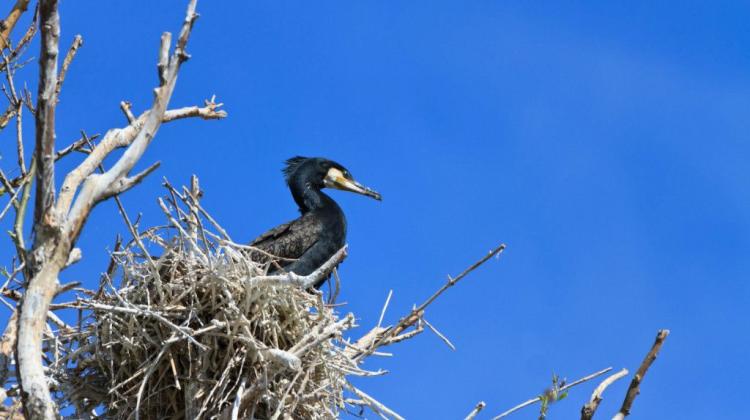Olsztyn/ Researchers counted cormorants in north-eastern Poland

The number of cormorants in north-eastern Poland has remained at approx. 6 thousand breeding pairs for several years, and the birds of this species catch more fish in the lakes than professional fishermen - according to research of the Inland Fisheries Institute in Olsztyn.
Conclusions from the study of the population of cormorant conducted for 10 years by the Olsztyn Institute, were presented in Krutynia in Mazury during the national conference of fishing users of lakes, rivers and reservoirs.
It is estimated that the rapid growth of the cormorant population in Europe has continued since the 1980s. In Poland in 1992 there were more than 8 thousand nests located in 32 colonies, and in 2013 the Polish population of this species was estimated at 26 thousand breeding pairs nesting in more than 50 colonies.
Piotr Traczuk of the Inland Fisheries Institute told PAP that the monitoring carried out since 2005 in Warmia, Mazury and Suwałki region shows that in these areas there is a very large and permanent population of cormorants. He said that regardless of culling and weather conditions, 5,3-6,4 thousand pairs nest there every year in more than 20 colonies, one quarter of the Polish population of the species. This is over three times more than 20 years ago.
Research shows that in each nest on average of 2.2 chicks hatch and are raised. This means that after young birds fly out of the nests, at the end of July or in August, more than 30 thousand cormorants live on the lakes of Warmia, Mazury and Suwałki region. In addition to adult birds and their offspring there are also young birds, still sexually immature, which have not started to breed.
Employees of the Inland Fisheries Institute estimate that cormorants feeding on the lakes of the north-eastern Poland eat a total of nearly 1.2 thousand tons of fish every year. Cormorants account for approx. 80 percent fish eaten by all predatory animals. That\'s more than the fish caught in the area by professional fishermen (approx. 1 thousand tons), and a little less than anglers catch (approx. 2 thousand tons).
The Institute also studied the composition of the diet of cormorants. Analysis of pellets and fish coughed out by these birds shows that the most frequent prey of cormorants are roach and perch, followed by the bleak and bream, but they also eat a lot of pike, zander and tench. A significant percentage of cormorant food are therefore fish species that are valuable from an economic and environmental point of view.
In addition, cormorants prey mainly on small fish, with an average body length of approx. 12-14 cm. They are mostly juvenile fish, originating from the recent stocking or natural reproduction, which have not yet spawned.
According to Traczuk, this means that cormorants not only eat up a significant amount of fish, but also adversely affect the composition of the lake fish fauna and reduce the effectiveness of stocking, which - he said - has negative effect on financial results of the fishing users and leads to a decrease in the production of fish in the lakes.
In his opinion, excessive numbers of cormorants also bring harm to nature. Droppings of these birds, rich in nitrogen and phosphorus, lead to the death of trees in colonies and pollute lakes.
Cormorants in Poland are covered with partial legal protection, which prevents their indiscriminate killing. Fish farms operating the lakes and pond owners must apply to the Regional Directorate of Environmental Protection for culling permits, justified by the need to reduce losses in the utilized water reservoirs.
This year alone, the Regional Directorate of Environmental Protection in Olsztyn authorized the culling of 1610 of these birds, approx. 200 individuals more than in previous years. But the fishermen had never been able to reach the full limit of approved culling - for example in 2015 in Warmia and Mazury 744were culled, and a year earlier 564 birds of this species. Shooting is permitted outside the breeding season, from 1 August to the end of the year.
According to Traczuk, it is difficult to assess whether culling brings results if it does not reduce the cormorant population. He reminded that fishermen bear the costs of both feeding of these birds and culling.
"We believe that the cormorant population is too large, and at the same time there is a lack of activities of relevant departments to resolve this situation" - he said.
The conclusion that Poland lacks a cormorant population management strategy was also included in the report of the Supreme Audit Office of April 2014, which audited the fishing management on the lakes of the Treasury in the Warmia-Mazury province.
"Since 2009, the Ministry of Environment has been working on a document, which should be immediately completed and implemented. The cormorant problem is not limited to Poland, but affects also other countries of the European Union, which is why solving this problem should be approached at the international level" - wrote the authors of the Supreme Audit Office report.
PAP - Science and Scholarship in Poland
mbo/ son/ mrt/
tr. RL
Przed dodaniem komentarza prosimy o zapoznanie z Regulaminem forum serwisu Nauka w Polsce.















